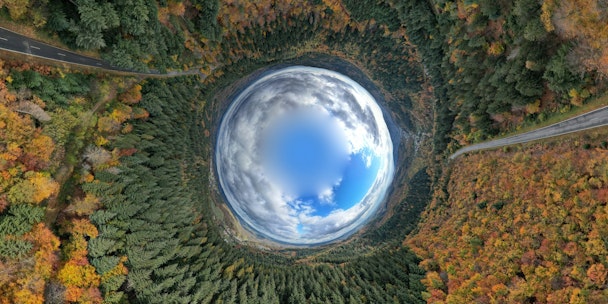What actually is immersive marketing (and where is it headed next)?
The Drum Network recently hosted a panel of immersive marketing leaders with experiential shop Pixel Artworks.

'Immersive marketing': What is it, really? And where's it headed next? / Bernd Dittrich via Unsplash
Obscenity, good art, ducks, elephants: it’s often hard to define a thing, but easier to say, “I know it when I see it.”
So it is with one of marketing’s present fascinations: ‘immersive’ experiences. With ‘experiential’ shops doing everything from conferences and trade shows to holograms and light shows, it can be hard to define what ‘experiential’ and ‘immersive’ really mean.
But we know proper immersion when we see it. Probably the most literally immersive activation we’ve seen so far is Adidas’s ‘swimmable’ billboard, which could actually surround you with water. Then you have the likes of Las Vegas’s MSG Sphere, London’s 180 Strand and the Outernet: commercial and entertainment spaces that surround visitors with screens and sound.
Then there’s digital immersion, like Moncler’s ‘immersive’ fashion shows, and in-store immersion, like Lego’s brick labs (which achieved the impressive feat of charging for admission to a shop). Then, the big, splashy, tech-driven PR plays that perhaps aren’t fully immersive per se but do seem to take us into a different reality, like that viral Resident Evil billboard and the AI-driven fakes of the same phenomenon.
Advertisement
The hallmarks of immersion: a rough definition
A robust definition of the immersive space may not be possible, but we can start to build one from some common factors.
First, an immersive experience will create a feeling of entering a world beyond our own. Tom Burch, managing director of Pixel Artworks, says that immersion “is going to take you away from what you were just thinking about and into another world.” Lisa Wrake, creative director of content at Jack Morton, describes this as having “something that you enter; that you go into… it’s a destination. That could be in real life or it could be it could be digital.”
Second, if immersion means creating a new world, it puts the creator in the role of a god, with influence over as many aspects of the experience as possible. Burch calls this “controlling the whole environment.”
Third, most immersive experiences will have a participatory element. Jonathan McCallum, senior vice-president and managing director for UK & Norway at George P Johnson, says: “It’s [about] the role you play there. In an immersive experience, you participate more… Without somebody in it, that the actual experience wouldn’t exist.” This is what immersive marketing shares with immersive theater: some degree of interaction between exhibitor and audience.
So, there’s immersion, a feeling of a new world, total creator control and audience-experience interaction. Crucially, our panel says, that doesn’t mean technology has to be involved. Theater can fit this description; to an extent, so can a book. As Charlotte Willcocks, head of strategy at Impero, puts it, when modern marketers talk about immersion, “your brain automatically goes to ‘digital’ and ‘expensive’ – clients’ brains do too, especially when you think about technology. But I think it’s really about the broadening of immersion: the theater and the brand experience you [create].”
Advertisement
Growing respect, measurement and integration
Technology may not be everything in this space, but it has helped marketers to realize long-held ambitions, says Wrake. For a long time, “the technology wasn’t quite there to realize some of our concepts, but now it is… what we’re able to do is amazing.”
And that same tech has primed audiences to be receptive to the kinds of experiences marketers want to show them: those immersive catwalk shows and rock concerts have spurred both innovation and desire. Here’s Wrake again: “Audiences are expecting it; they want brands to speak to them in that space; they want them to bring that kind of joy. That’s what we can do with immersive marketing: you can touch all the senses… it’s a playground. It gives them a chance to be rockstars – you can have collaboration with bands, with fashion… it allows that blending of the different creative areas you maybe can’t get in other traditional spheres.”
From an advertising business point of view, our panel says that immersive and experiential are coming into a position of maturity, as we’re increasingly “treating it as the legitimate channel that it is, not a shiny new technology… it’s not a fad, it’s actually useful,” says Impero’s Willcocks.
To keep building on this legitimacy, two things need to keep happening: measurement must keep improving, tying immersive performance to business results, and expertise integration must keep deepening.
On measurement, the news is mostly good, with an expanding array of tools to measure immersive performance. There’s high-tech measurement (footfall heatmaps, software to measure emotional response via video), but there’s also the old-school – what McCallum calls “controlling the threshold” to understand, at least, who has seen the activation. Then there’s measuring fame and PR by social listening and impact on revenue. The latter could bear improvement, says Burch, to show “whether that connection with that experience at that point in time impacted their buying behavior in 18 months’ time… there are less tried-and-tested tools in that space”.
And on expertise, as technological complexity expands, so does the array of skillsets required – and potential pitfalls. “You’re working with time – you’ve got your customers for longer, so you’ve got more time to make mistakes,” says Wrake. “You need to work with people who understand content, who understand film, who understand sound. You’ve got a lot of elements that come into play.”
Suggested newsletters for you
Packaging experiences
Another live question for purveyors of immersive marketing is how to sell them. Often, experience options will be expensive; securing clients spend for a big, bold, immersive play can be tricky. The answer is one of the oldest tricks in the pitching book, says Wrake. “We’ll present something that is bigger and grander and more expansive than we know that they will be able to do, but have a couple of levels of backup.” The key, she says, is “being able to keep the core of the idea but strip out the technology, or the screens, but still keep that initial core going through it… you know that you’re probably not going to get that sort of 300-foot LED screen, smell-o-vision and the hologram.”
McCallum has another suggestion: experiential shops have traditionally sold work with fixed outcome and price, “whereas digital agencies sell an iterative process and they break it down. They take clients on the journey through minimum viable products; you might not know what you’re going to get at the end, but the journey is going to be really fun. You pay along the way and you’ll get something brilliant. They sell the journey.” Minimum viable product may not work in experiential (“there’s no minimum viable experience”), but adopting that iterative process may be fruitful, McCallum says.
In their approach to tech, teams and business models, experience thinking among marketers has grown rapidly but has plenty of room for growth yet. For Burch, “It has certainly come a long way and it’s not over yet.”
Panel moderated by Niki McMorrough. You can watch a full video of the session over on The Drum TV.
Content created with:

Pixel Artworks
We design and deliver awe-inspiring shared immersive experiences to help clients build unique, effective and lasting connections with their audiences.
Find out more
Impero
Hello. We Are Impero.
The creative agency for impatient brands.
We're audaciously ambitious. We like to challenge the status quo by thinking bigger,...

Jack Morton
No one sets out to be average. No one aspires to be ordinary. Jack Morton is an award-winning global brand experience agency that exists to reimagine what an experience...
Find out more
George P. Johnson
George P. Johnson is the world’s leading experiential marketing agency. We power brand experiences by enabling marketers to benefit from integrated experiential...
Find out more
